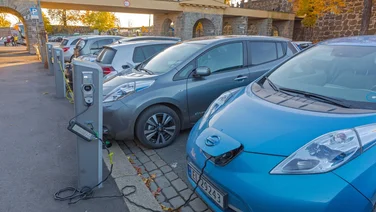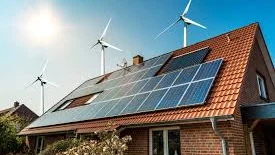- Should you get a domestic wind turbine?
- How much does a domestic wind turbine cost?
- How much money will a domestic wind turbine save you?
- When will you break even on a domestic wind turbine?
- Is your home suitable for a domestic wind turbine?
- Do you need planning permission for a domestic wind turbine?
- Are there any better alternatives to a domestic wind turbine?
- Summary
- FAQs
✔ Domestic wind turbines cost between £2,000 and £70,000, depending on size
✔ Standalone wind turbines could save you £741 a year on electricity
✔ The lifespan of a domestic wind turbine is around 20 years
Small domestic wind turbines are a way for UK homeowners to produce free, green electricity using wind power. Yet, according to MCS data, only 125 have been installed across the UK.
This is a very small number compared to the 427,460 residential solar panels that have been installed across the UK, so you might be wondering if domestic wind turbines are worth the investment.
In this article we’ll give you a breakdown of the cost, potential savings, and breakeven times of domestic wind turbines. We’ll also tell you which properties are most suited to them, and explain planning regulations.
Don’t think a domestic wind turbine will be right for your home? Solar might be a better fit. To find out whether your home could benefit from a set of panels, head to our Complete Guide to Solar Panels.

Should you get a domestic wind turbine?
You should only get a domestic wind turbine if you live in a rural area and have enough space on your property for a standalone wind turbine (the kind that is mounted in the ground).
Standalone wind turbines are better value for money than roof-mounted ones because even though they are more expensive, they produce much more electricity.
For example, a 1.5 kilowatt (kW) standalone wind turbine will produce around 2,080 kilowatt hours (kWh) a year, while a 1 kW roof-mounted turbine only produces 844 kWh.
As you can see, you’ll get a much better return on your investment with a standalone wind turbine.
We’ve summarised the costs, power output, savings, and break-even points you can expect for domestic wind turbines of various sizes in the table below.
System size/type (in kilowatts) | System cost | Output (in kilowatt-hours) | Savings (with SEG) | Break-even point |
|---|---|---|---|---|
1 kW roof-mounted | £2,000-£3,000 | 844 kWh | £177 | Never |
1.5 kW standalone | £7,000-£10,000 | 2,080 kWh | £438 | 19.4 years |
2.5 kW standalone | £12,500-£18,000 | 3,520 kWh | £741 | 20.6 years |
5 kW standalone | £23,500-£30,550 | 7,120 kWh | £1,499 | 18 years |
10 kW standalone | £45,000-£58,500 | 17,200 kWh | £3,621 | 14.3 years |
How much does a domestic wind turbine cost?
The cost of a domestic wind turbine will depend entirely on the type of wind turbine. Generally speaking, the bigger the turbine, the higher the cost.
Small roof-mounted wind turbines usually aren’t more than 0.5-1.5 kW, and cost around £2,000 to 3,000, including installation.
Standalone (or pole-mounted) turbines can vary a lot in size and, therefore, in price. They can cost anywhere from £7,000 for a 1.5 kW system, to £70,000 for a 15 kW system.
Installation, and cabling to establish a grid connection, can increase the total cost by up to 30%.
This is quite a lot to pay for a green energy system, especially when you consider that solar panels cost £7,860 on average, including installation.
How much money will a domestic wind turbine save you?
The amount of money a domestic wind turbine could save you will depend on several factors, including the size and height of the wind turbine, the local wind speed, and the number of hours of strong wind an area gets.
If we take the average annual wind speed in the UK of just under 10 miles per hour (mph) as a baseline, a 2.5 kW domestic standalone wind turbine could save you around £741 a year on your electricity bills. This is almost 80% off electricity bills for the average three-bedroom house.
Small roof-mounted wind turbines will save you a lot less. For example, a 1 kW roof-mounted wind turbine could save you around £177 a year on your electricity bills, or around 20% off the average home’s electricity bills.
These figures include earnings from the Smart Export Guarantee (SEG). Without the SEG, a 2.5 kW standalone wind turbine could still save you around £530 a year, or 60% off the average home’s electricity bills.
That’s more than a solar panel system, which can save a typical three-bedroom house £398 on their electricity bills without the SEG, and £557 with the SEG. However, since solar panels cost half as much as standalone domestic wind turbines – and have a longer lifespan – they’ll pay for themselves much sooner.
Can you get paid for the electricity you generate with a domestic wind turbine?
Yes, you can get paid for the excess electricity you generate with a domestic wind turbine if you use the government’s Smart Export Guarantee (SEG) scheme.
Under the SEG, 13 energy suppliers have been licensed to pay homeowners for green electricity that they export to the National Grid. This includes electricity generated from wind turbines, solar panels, micro-combined heat and power, hydropower, and anaerobic digestion.
Licensed suppliers include British Gas, Scottish Power, and Octopus Energy, which offer the current best rate – 24p for every kWh of green electricity customers export.

When will you break even on a domestic wind turbine?
It’ll take around 20.6 years to breakeven on a 2.5 kW standalone domestic wind turbine. This is also the average lifespan of a domestic wind turbine, so the return on investment isn’t great.
However, return on investment usually gets better the bigger the wind turbine is. A 5 kW standalone wind turbine, for example, has a breakeven point of around 18 years, and a 10 kW wind turbine has a breakeven point of 14.2 years.
That being said, most households won’t need a domestic wind turbine larger than 5 kW, at most, to meet their electricity needs.
Unfortunately, roof-mounted wind turbines have an even worse return on investment. It would take hundreds of years to breakeven on a roof-mounted wind turbine through electricity bill savings, which is far more than the wind turbine’s 20 years lifespan.
Is your home suitable for a domestic wind turbine?
Domestic wind turbines are most suited to homes in rural areas that have lots of open space around them.
To ensure domestic wind turbines generate electricity, they need to be in an area free from obstructions that could disrupt the wind. The general recommendation is that domestic wind turbines are placed at least 150 metres away from obstructions.
This means if a property is surrounded by tall buildings, trees, or large hills, it won’t be suitable for a domestic wind turbine. The ideal location for a domestic wind turbine is an elevated and large open space, in a coastal or rural area, that has an average annual wind speed of 10 mph.
For standalone wind turbines, homeowners also need to make sure they have enough land space – around 30 square metres – to ensure that the wind turbine is at a safe distance from your house and your neighbours’ property.
Roof-mounted wind turbines are usually only permitted on detached houses for them to be considered a safe distance from neighbouring roofs.
Wind is a popular form of green energy in the UK, with almost half of Brits saying they wouldn’t mind living next to a wind farm, according to our National Home Energy Survey.
Do you need planning permission for a domestic wind turbine?
Whether you need planning permission or not for a domestic wind turbine will depend on the type and size of the wind turbine, as well as where you live in the UK. Regulations vary between England, Scotland, Wales, and Northern Ireland.
If you live in a listed building, you will need to get planning permission for a domestic wind turbine, no matter where you are in the UK. Bear in mind that you might not be permitted to install a roof-mounted wind turbine because this would alter the external appearance of your property.
The rules in Northern Ireland are quite simple: planning permission is required for all roof-mounted and standalone domestic wind turbines.
The other devolved nations have a complex set of rules and requirements, so we’ll provide a summary for each in the following sections.
England
As long as they meet the criteria set out by the Planning Portal, standalone and roof-mounted wind turbines do not require planning permission in England.
This includes a list of requirements around the height and width of the domestic wind turbine as well as its distance from any surrounding buildings – or highways, which is the case for properties in conservation areas.
For example, standalone wind turbines mustn’t be more than 11.1 metres in height.
Additionally, if the property already has a heat pump installed, and the homeowners want to install a domestic wind turbine, then they will need to apply for planning permission.
Scotland
In Scotland, all roof-mounted domestic wind turbines require planning permission.
Standalone wind turbines do not require planning permission, but homeowners still need to submit an application to their local planning authority to have the size and design of the wind turbine approved.
The Scottish government website doesn’t specify any size or distance requirements for standalone domestic wind turbines, so the Energy Saving Trust recommends that homeowners check what rules apply in their local area.
The only blanket rule is that a standalone domestic wind turbine should be more than 100 metres away from another property. Additionally, standalone wind turbines are not permitted in certain places, such as conservation areas, World Heritage Sites, or land reserved for scientific research.
For full legislation, we recommend you check the Scottish government’s guidance page on permitted development.
Wales
Wales also requires planning permission for roof-mounted wind turbines.
Standalone wind turbines do not require planning permission, and the rules and restrictions for them are the same in Wales as they are in England. For example, planning permission is required if the property already has a heat pump installed.
Full guidance can be found on the Welsh government’s website.
Are there any better alternatives to a domestic wind turbine?
Residential solar panels are a great alternative to domestic wind turbines. They are less expensive, costing around £7,860 in total for the average three-bedroom household, compared to a minimum of £12,500 for a 2.5 kW standalone wind turbine.
Even though solar panels generate slightly less electricity than standalone wind turbines, they have a much better return on investment. It takes around 14.11 years to break even on solar panels – bearing in mind that they can last 35 years – with annual savings of £551 on average.
Another alternative way to generate green electricity is through a hydropower system, which is, basically, a water turbine. These are really only an option if you have a water source that runs through your property, such as a river or stream.
A hydropower system can be expensive, and generally costs around £20,000. However, it can last up to 50 years – more than double the lifespan of wind turbines – so if the flow of water is decently strong, you’re likely to see a return on your investment in a little over a decade.
Solar panels are by far the most popular form of domestic green electricity generation. Currently, 427,460 solar panels systems and 125 domestic wind turbines have been installed in homes across the UK, according to MCS data.
Estimates aren’t available for domestic hydropower but, given the limited number of homes that are suited to it, we could safely assume the numbers are low.
Summary
When it comes to domestic wind turbines, our advice is to go for a standalone wind turbine, if possible.
Roof-mounted wind turbines won’t save you enough for you to breakeven on your purchase. Although, this won’t be a problem if your only concern is using more green energy.
However, standalone wind turbines are more worth it financially, although it is worth highlighting that the cost of installing one is so high that you’ll still only see a return on your investment when the wind turbine is nearing the end of its lifespan. But again this won’t be an issue if you just want to use more green energy.
Plus, if you’re looking to go off-grid, a standalone wind turbine is a good investment because it could cover all your electricity needs.
For everyone else, solar panels are more worthwhile. They cost less than wind turbines, will save you money on your electricity bills, and they have a shorter breakeven point than domestic wind turbines.
FAQs
How big of a wind turbine do I need to power my house?
A 2.5 kW standalone wind turbine, installed in an area with an average annual wind speed 10 mph, should provide enough electricity to meet around 80% of the average three-bedroom home’s electricity needs. Larger homes that use a lot of electricity might require a 5 kW standalone wind turbine, but most residential properties will not need one bigger than that.
Can I put a wind turbine in my garden?
Yes, you can technically put a small domestic wind turbine in your garden. However, you need to make sure you have enough space in your garden to legally do this. In England and Wales most domestic wind turbines need to be at least 12 metres away from the boundary of a property, and in Scotland they need to be at least 100 metres away.
Are domestic wind turbines loud?
Domestic wind turbines are not particularly loud. When in operation, a domestic wind turbine will produce noise at around 43 decibels, around the same noise levels as an air conditioner. And, of course, the further away a wind turbine is from a property, the less you will hear it.






